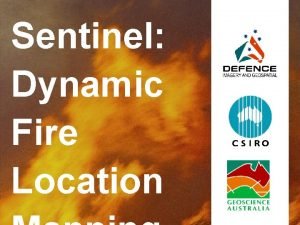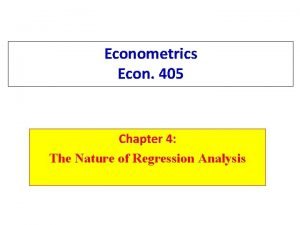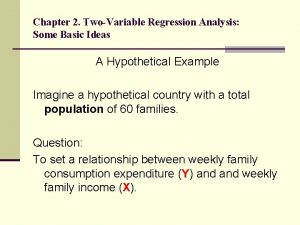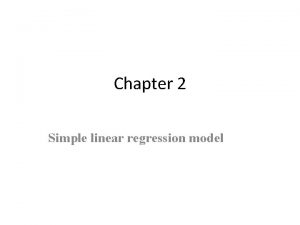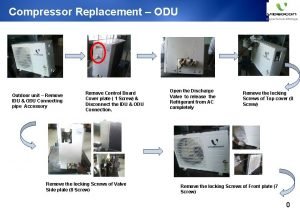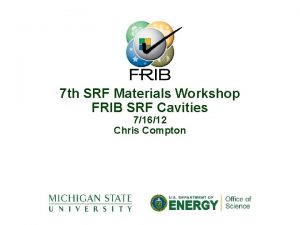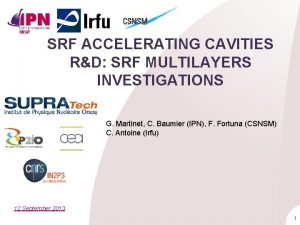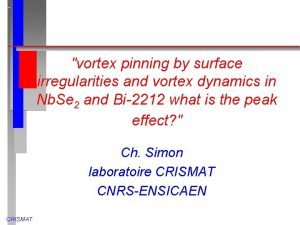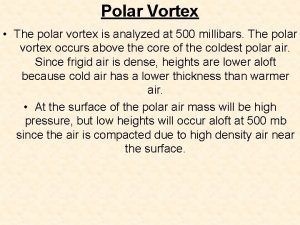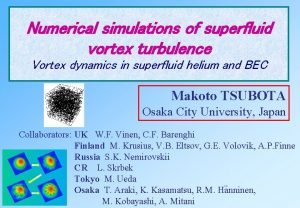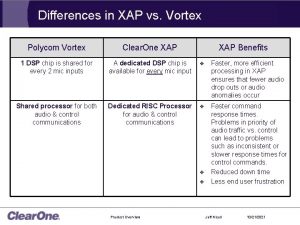Vortex hotspots in SRF cavities Alex Gurevich ODU












- Slides: 12

Vortex hotspots in SRF cavities Alex Gurevich ODU Department of Physics, Center for Accelerator Science 7 -th SRF Materials Workshop, JLab, July 16, 2012

Outline • Hotspots due to trapped vortices: How do vortices get trapped in a Nb cavity? • Moving vortex hotspots by thermal gradients • Variety of different vortex configurations • Dissipation due to trapped vortices • Hotspots produced by vortex wagging tails: complicated dependence of dissipation on the mean free path, frequency and the length of vortex segments • Reconstruction of hotspot sources revealed by thermal maps

Why are vortices relevant to cavities ? Nb Cooldown in field from T > Tc to 2 K H(t) RF field § Vortices can be trapped in a cavity upon cooling below Tc § Vortices trapped at the inner cavity surface oscillate under the RF field producing hotspots λ London penetration depth of superconducting currents ≈ 40 nm << d = 3 mm § Even a few trapped vortex bundles can produce RF power comparable to the exponentially small BCS surface resistance: Δ ≈ 17. 5 K for Nb

Moving vortices by thermal gradients § Thermal force acting on the vortex: § The condition: f. T > Jc 0 gives the critical gradient, which depin trapped vortices: For clean Nb with Bc 1 = 0. 17 T, Jc = 1 k. A/cm 2 and T = 2 K: | T|c = 1. 6 K/mm Experment Ciovati and Gurevich, Phys. Rev. STAB 11, 122001 (2008); Gigi Ciovati, this conference Any change of thermal maps after applying local heaters (laser beams) indicates that hotspots are due to trapped vortices rather than fixed defects

Parallel vortices near the oscillating surface barrier Gurevich and Ciovati, Phys. Rev. B 77, 104501 (2008 d H 0 • Vortex viscous drag: = 0 Bc 2 /ρn u(t) • Onset of vortex penetration Bv = ϕ 0/4πλξ = 0. 71 Bc • Vortex time constant: τ = μ 0λ 2 Bc 2/Bvρn ≅ 1. 6× 10 -12 s for Nb 3 Sn, ρn = 0. 2 μΩm, Bc 2 = 23 T, Bc = 0. 54 T, λ = 65 nm • Supersound initial vortex velocity v = λ/τ ≅ 400 km/s x ℓ dm • Penetration times much shorter than the rf period (instant for the SRF cavities) • Bardeen-Stephen viscous vortex drag is inadequate for high velocities; jump-wise instabilities (Larkin-Ovchinnikov and overheating) of vortex oscillations

Wagging vortex tail u(z, t) Vortex viscous drag coefficient 2 λ l H(t) Nonlocal vortex line tension for isotropic materials

Dissipated power a = ℓ/λ > 1 is the length of the vortex segment and b = ωηℓ 2/ε 0 is the dimensionless frequency Long segments, b > 1 Frequency dependence Short segments, b << 1

Low frequency limit § Quadratic frequency dependence § Increases as the surface gets dirtier § Increases strongly for longer vortex segments Low frequency means f << f 0 where For a vortex segment with ℓ = 1μm in Nb (ρ = 10 -9 Ωm), we get f 0 = 2. 5 GHz For 2 GHz Nb cavities, short vortex segments with ℓ ≲ 1 μm are in the low-frequency limit

High frequency limit, b >> 1 § Independent of frequency § Independent of the length of the vortex segment § Decreases as the surface gets dirtier § Long vortex segments with ℓ ≳ 1μm § Sparsely distributed (more than ≳ 1μm apart) pinning defects Single vortex in Nb ( = 40 nm, n = 10 -8 Ohm*m, B = 0. 1 T, Bc 2 = 0. 4 T): Q 2 W

Reconstruction of thermal maps How much RF power is dissipated in the hotspots based on the measured temperature distribution on the outer cavity surface ? General reconstruction scheme was developed based on the solution of the 3 D thermal diffusion equation: Boundary conditions: Separate the BCS dissipation from the localized vortex hotspot

Temperature distribution on the outer surface Thermal decay length on the outer surface: Hotspots can ignite lateral thermal quench

Conclusions § Hotspots produce RF dissipation comparable to the BCS dissipation § Moving or splitting hotspots by thermal gradients (laser beam) indicates that they result from trapped vortices rather than fixed structural defects § Vortex hotspots can be dispersed by laser but not easily eliminated § Complicated dependencies of the vortex wagging tail dissipation on the rf frequency, mean free path and length of vortex segments: - Short segments for denser pinning centers: ℓ ≲ 1μm: Q ∝ B 2ω2ℓ 3 increases as ω and ℓ increase. The cleaner the better. - Long segments for sparser pinning centers: ℓ ≳ 1μm: Q is independent of ω and ℓ. The dirtier the better. § Reconstruction of hotspot sources from thermal maps. Thermal map microscopy. § Trapped vortex bundles can account for the hotspots observed by thermal maps





